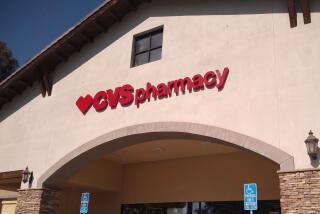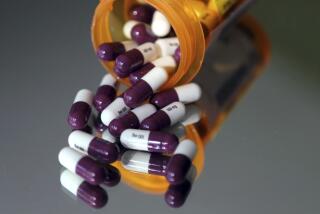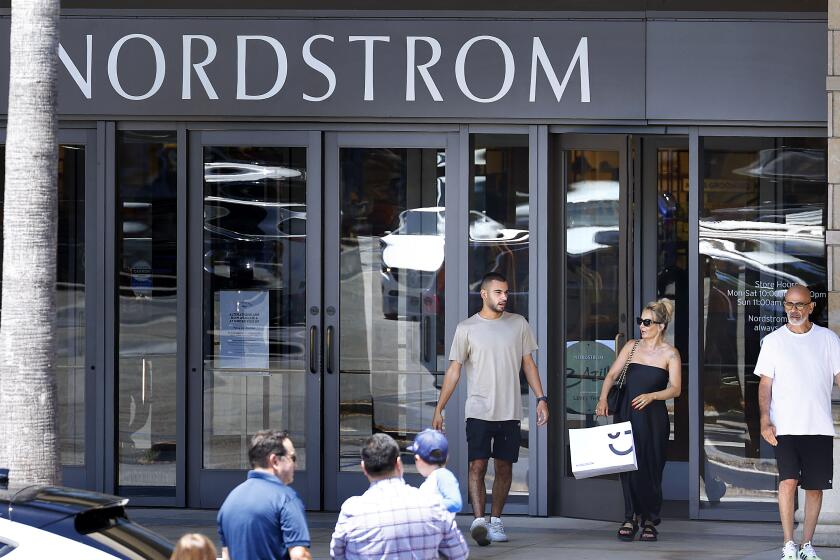Doctor, just a little something for you
- Share via
As guardians of the nation’s prescription pads, doctors are the gatekeepers that stand between American patients and the pharmaceutical companies that have drugs to sell them.
Physicians’ choices -- whether to medicate, with which medication, generic vs. brand-name drug, and for how long -- profoundly affect sales of a drug company’s products. So pharmaceutical manufacturers focus the bulk of their marketing budgets to influence those choices. The drug companies’ promotional efforts reach into physicians’ offices, pervade their medical specialty organizations and often shape the messages that doctors receive in educational settings.
“There is a big bucket of money sitting in every office” a drug representative visits, said an AstraZeneca marketing director in a widely circulated newsletter interview. “Every time you go in, you reach your hand in the bucket and grab a handful,” said Mike Zubillaga, who was fired after his blunt comments made their way onto the Internet last April.
Each day in the United States, an army of roughly 100,000 pharmaceutical company sales reps storms the waiting rooms and offices of the nation’s 311,000 office-based physicians. Called “detailers” -- and earning, on average, $81,700 per year -- they are the smiling, well-dressed men and women often seen in a physicians’ waiting room toting a cavernous briefcase and making small-talk with the receptionists. Their ranks have more than doubled in the last 10 years.
Sales reps say they want nothing more than to drop off drug samples that doctors can dispense at no cost to their patients, and to brief physicians on the FDA-approved benefits and risks of the prescription drugs their companies make. That’s an accurate job description. But it doesn’t nearly capture the sophistication of their efforts or the complex web of relationships that marketing departments cultivate with physicians. In recent years, drug-company insiders have come forward to detail the enticements, persuasive techniques and market-tracking systems that their organizations use to nudge doctors’ prescribing decisions to boost sales. The picture they provide is of an industry in hot pursuit of physicians’ hearts and minds.
--
Relationships with drug reps
The inducements that doctors accept are more than just pads, pens and gadgets such as the Viagra calculator that stands up on its base when the “on” button is pushed. A national survey of doctors published in the April 2007 New England Journal of Medicine found that 94% of physicians in the six specialties studied reported some type of relationship with pharmaceutical companies’ representatives. Most (83%) received food in their workplace, or accepted drug samples (78%) proffered by visiting representatives. Thirty-five percent reported that drug companies had reimbursed them for the cost of attending professional meetings or company-sponsored sessions that satisfied a physician’s “continuing medical education” requirement. And 28% received payments for consulting with a drug company, giving lectures or enrolling patients in trials.
The American Medical Assn. and the pharmaceutical industry group PhRMA adopted non-mandatory codes of conduct in 2002 that discourage the offering or acceptance of items that bring only “personal benefit” to a physician. Shahram Ahari, a former drug rep with Eli Lilly, says that in many cases, those guidelines have given the practice of gift-giving “a nice veneer of respectability.”
But the practice’s impact is often unaltered -- and may even be greater than when drug reps were permitted to offer extravagant gifts such as theater tickets and golf bags. That is because psychologists have shown consistently that a small token or gesture of friendship often inspires a sharper sense of obligation in the recipient than does a showy gift, for which reciprocation is impossible.
Moreover, Ahari says, “the amount of money invested in gifts hasn’t changed. In the past, I could spend $100 on a golf club and give it to you. Now, I can spend $100 on a textbook you need so you can spend your own $100 on that golf club.”
Sales reps bear many gifts, but none is more important than the prescription drug samples they bring to doctors. In 2003, the pharmaceutical industry distributed $16.4 million worth of them to doctors, according to PhRMA, the industry’s most important trade group.
“For me, that’s access,” Ahari says. “The doctors are first grateful that you’re giving them samples, because it makes them seem like a hero to patients . . . and when they feel that sense of gratitude, they feel obliged to spend some time with the drug rep delivering them.” But in the end, it is the patient who often will pay more, because even a short course of sample use builds customer loyalty to a brand-name drug, even when a generic or a cheaper, older drug might be just as effective.
Among the not-so-well-kept secrets of the medical world is the physical attractiveness of the men and women who make up the pharmaceutical sales-rep force. “It seems pretty cynical,” says UCLA internist Dr. Martin Shapiro. “I mean, the people that do the detailing aren’t your average-looking individuals.”
Ahari laughs at the description. Pharmaceuticals’ marketing departments look to hire “young, attractive people, quite charismatic” -- and scientific training is completely optional, says Ahari, now a researcher at the UC San Francisco’s School of Pharmacy, who describes his former profession on a website ( www.Pharmedout.org) devoted to exposing drug company marketing practices.
“They’re looking for gender icons -- cheerleaders and ex-military types -- fun to be with, someone with whom you’d like to have a beer or watch a game,” Ahari says. To establish friendship and assure access to a physician, a detailer “will scour a doctor’s office for objects -- a tennis racquet, Russian novels, ‘70s rock music,” wrote Ahari and Adriane Fugh-Berman, a Georgetown University physician, in an article published by the Public Library of Medicine in April.
Small practices and family physicians are most intensively courted. And doctors whose prescribing practices are not circumscribed by healthcare companies or hospital formularies get extra attention as well. According to the New England Journal of Medicine survey published last April, family practitioners reported they met with pharmaceutical-company detailers, on average, 18 times per month, more than four times the average for all doctors that was reported in a 2000 study. Trailing not far behind them were internists (10 meetings per month), cardiologists (nine) and pediatricians (eight).
Outside the confines of a doctor’s office, pharmaceutical marketing efforts become more extravagant.
At physicians’ association meetings and at conferences and seminars that provide “continuing medical education” for doctors, drug-company sponsorship is substantial. Both have become important venues for courting physicians over meals and in appealing venues. Both provide opportunities for drug companies, indirectly, to pay speaking fees to favored physicians. And a recent Senate Finance Committee report concluded that, in spite of efforts to stem the practice, both are used by pharmaceutical companies to boost physicians’ prescribing of their products.
--
Sponsorship of seminars
At a recent hearing of the Senate Committee on Aging, Dr. Jerome Kassirer of Tufts University School of Medicine described meetings of medical societies and associations as “mini-circuses, replete with enormous glittering displays and hovering attractive personnel. Although couched as education,” he added, “these marketing efforts are thinly disguised bribes.”
UCLA internist Shapiro, who as president of the Society for General Internal Medicine in 2002 sought to limit drug company sponsorship, calls it “the walk of shame.” At almost every major medical meeting he attends, he said, “there are these opportunities to get free things that are questionable -- and that clearly are not intended to sharpen the rational decision-making skills of a physician, but to have an impact . . . on how they prescribe medications.” It’s not enough, he added, to close your eyes and walk past them: Pharmaceutical company money has largely underwritten the programs doctors will attend and the administration of the professional association that organizes the event.
Medical societies “have become dependent on the infamous ‘unrestricted grant’ from numerous pharmaceutical companies,” Dr. J. Gregory Rosenthal, a Toledo, Ohio-based retinal surgeon, told the Senate Committee on Aging in June. “In this context, ‘unrestricted’ means, ‘Use this for whatever you want, but if you ever want another, don’t displease us.’ ”
Physicians’ “continuing medical education” requirements also have provided drug companies ripe marketing opportunities, experts say. In 2005, drug companies spent $1.12 billion to fund sessions that physicians attend to maintain their license to practice.
In recent years, new guidelines have sought to distance those grants from companies’ marketing departments. Still, the Senate report noted, “drug companies routinely fund educational grants to support programs that favorably discuss the companies’ newer and more lucrative products, thereby encouraging physicians to prescribe these products and, ultimately, driving sales.” Where doctors are typically a skeptical audience for direct pitches, “when the favorable message is delivered in the context of education -- even if corporate sponsorship is disclosed -- there is an imprimatur ofcredibility and independence,” investigators noted.
Some of those programs appear to have been forums for pushing “off-label” uses for prescription drugs, a back-door means of expanding its market. About one-fifth of prescriptions that doctors write are for off-label uses -- to treat a condition other than that for which FDA has found a drug safe and effective. Although it’s legal for doctors to write off-label prescriptions, it is illegal for a drug manufacturer to market its drugs for off-label uses.
In 2004, Warner-Lambert (now a division of Pfizer Inc.) paid $430 million to settle claims that it was using continuing education grants to promote off-label uses of Neurontin, an epilepsy drug. In 2005, Serono Laboratories paid $704 million to settle claims in a case that alleged it was using educational programs to boost sales of the AIDS drug Serostim for off-label uses.
The 50 state attorneys general who accepted the settlement of the Neurontin case have used $21 million to establish the Consumer and Prescriber Grant Program, www.ohsu.edu/cpgp/, designed to provide healthcare professionals and consumers information related to prescription drugs and their marketing.
--
More to Read
Inside the business of entertainment
The Wide Shot brings you news, analysis and insights on everything from streaming wars to production — and what it all means for the future.
You may occasionally receive promotional content from the Los Angeles Times.











